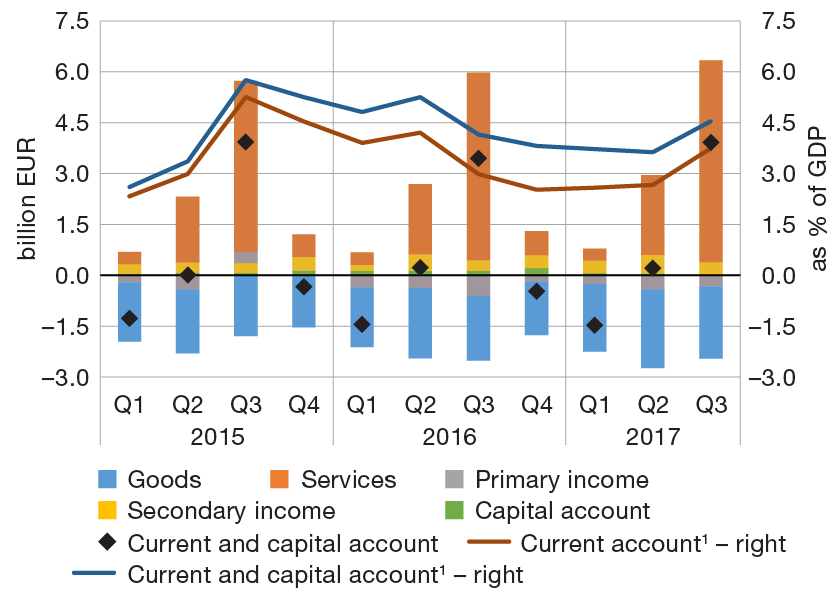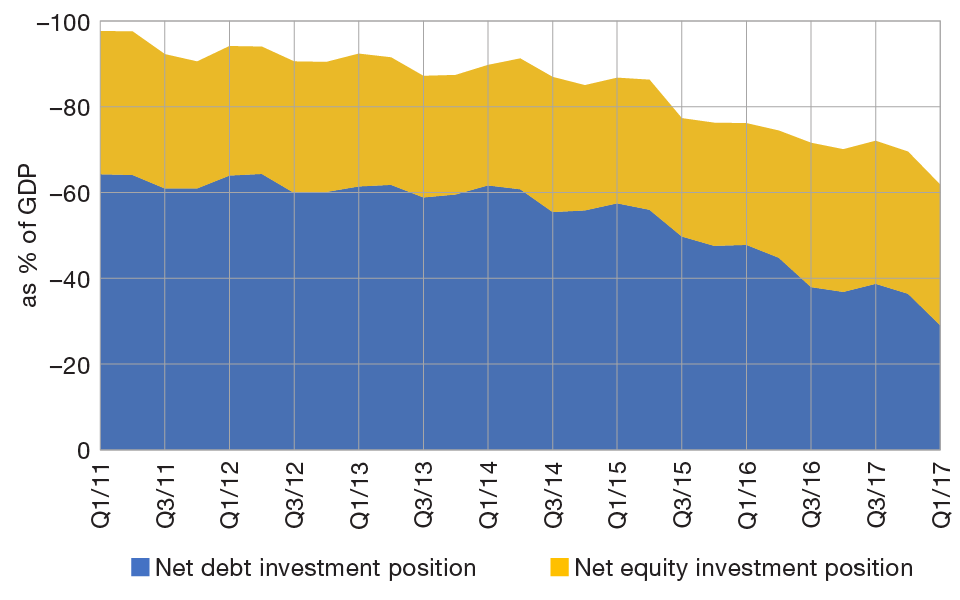From August 2023 the comments on statistics, a short description of selected, recently issued statistical data in the area of monetary statistics and the non-residents sector statistics, are no longer published. They are replaced by Statistical releases.
Comments on the balance of payments and the international investment position in 3Q 2017
The current and capital account showed a surplus of EUR 3.9bn in the third quarter of 2017, which is an increase of EUR 0.5bn from the same period in 2016. The positive developments in the current and capital account resulted from the significant growth in net exports of services (up by EUR 0.4bn from the same period in 2016) and the improvement of the balances in the primary and secondary income accounts. Only the balance of the foreign trade in goods deteriorated, at a pace similar to that in the previous two quarters. In the last four quarters to the third quarter of 2017, the surplus in the current and capital account accounted for 4.5% of GDP, its downward trend coming to a halt.
The widening of the goods trade deficit continued in the third quarter (up by EUR 0.2bn from the same period in 2016) due to somewhat faster growth in goods imports than goods exports (11.2% and 10.5%, respectively, on an annual basis). As regards the trade in services, the growth of net exports resulted from the growth of tourism revenues (9.8% on an annual basis). At the same time, however, tourism consumption of residents abroad increased relatively strongly (35.8% on an annual basis), its impact on the overall balance being several-fold weaker. In contrast, the balance of trade in other services worsened somewhat.
The negative balance in the primary income account almost halved compared with that in the third quarter of 2016. This was mostly due to more favourable balance of income from direct investment, marked by the decrease in expenditures brought about by the fall in profits of foreign-owned banks based on provisions for loans to the Agrokor Group and the rise in resident revenues from foreign investment[1]. Notwithstanding the direct investment income balance, the positive trends in the primary income account are also attributable to the upward trend in revenues from compensations to residents working abroad and the decrease in the negative balance of portfolio and other investment income. The latter is the result of smaller expenditures for interest on external debt, in part due to discontinued interest accrual on old external debt of the Agrokor Group (accumulated until April 2017).
The overall secondary income and capital account balance remained almost unaltered. Total net revenues arising from transactions with the EU budget remained almost the same in the third quarter of 2017 from the same period in 2016, with their structure undergoing considerable changes. Specifically, end beneficiaries were distributed significantly more funds for current expenditures, while the amount of distributed capital funds reduced sharply from the same period in 2016.
Figure 1 Balance of payments
| a) Current and capital account | b) Financial account |
 |
 |
* The sum of the last four quarters.
Note: In the figure above showing the financial account, the positive value denotes net capital outflow abroad and the negative value denotes net capital inflow.
Source: CNB.
The financial account of the balance of payments saw a net capital outflow of EUR 2.9bn in the third quarter of 2017 (up EUR 0.5bn over the same period in 2016). Broken down by account, the net capital outflow was recorded in the account of other and portfolio investment, international reserves edged up and only the account of direct investment saw a net capital inflow.
Strong net capital outflow in the other investment account (EUR 1.8bn) largely reflects the improvement in the net foreign position of banks during the peak tourist season. The net foreign position of the central government also improved slightly, while net liabilities of the central bank based on other investment deteriorated due to the growth in liabilities arising from investment of reserve assets in repo agreements[2]. Net liabilities of other domestic sectors in the account of other investment also rose slightly. Moreover, the account of portfolio investment saw a net capital outflow (EUR 0.4bn) due both to the deleveraging of the central government, which was slightly less pronounced than in the same period in 2016, and other domestic sectors.
International reserves trended up significantly in the third quarter (EUR 1.0bn), more than a half of this increase being accounted for by the previously mentioned investment of reserve assets in repo agreements and the remaining part by the purchase of foreign exchange from banks.
The net capital inflow in the account of direct investment of EUR 0.3bn in the third quarter of 2017 was to a large extent the result of reinvested earnings of business entities in non-resident ownership, its amount decreasing from the same period in 2016. At the same time, new inward equity investments of non-residents were relatively modest, amounting to only EUR 0.1bn. Resident outward equity investments reached the same amount, which was nevertheless substantially more than in the same period in 2016 and resulted from the change in ownership within one financial group.
Table 1 Balance of payments

1 Excluding the change in gross international reserves and foreign liabilities of the CNB (investment of a part of reserves in reverse repo agreements results in a simultaneous, same-amount increase in assets and liabilities of the CNB).
2 The sum of the last four quarters.
Note: The positive value of financial transactions denotes net capital outflow abroad and the negative value denotes net capital inflow.
Source: CNB.
As a result of the developments in the financial account, the net international investment position of the Republic of Croatia improved by EUR 3.2bn in the third quarter of 2017 thanks to improvements seen in the net debt position of domestic sectors, while the net equity position held steady. Overall, the net international investment position stood at EUR –29.8bn at the end of the third quarter of 2017, while the relative indicator improved to –61.8% of GDP (Figure 2).
Figure 2 International investment position (net)

Notes: The international investment position (net) equals the difference between domestic sectors' foreign assets and liabilities. Net debt investments include financial derivatives.
Source: CNB.
Data revision
Data on the balance of payments and the international investment position are revised in accordance with the commonly used practice, based on data obtained after the last quarterly dissemination.
Detailed balance of payments data
Detailed data on the international investment position
As several activities did not generate losses in the third quarter of 2017, which marked the previous part of the year, the growth of revenues from resident foreign investment is inter alia related to the base period effect. ↑
Investment of international reserves in reverse repo agreements results in a simultaneous change in assets (recorded in the account of reserve assets) and liabilities (recorded in the account of other investment) of the CNB and thus has a neutral impact both on changes in the net foreign position of the central bank and the overall financial account balance. ↑
